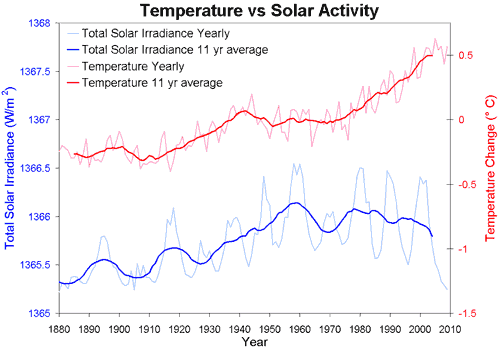2009 - 2nd hottest year on record while sun is coolest in a century
Posted on 16 January 2010 by John Cook
The skeptic argument "It's the sun" is both the most used skeptic argument and the most visited page on this website. So with NASA GISS updating the surface temperature record with completed 2009 data, I've updated the comparison between sun and temperature. While 2009 is the second hottest year on record (tied with 2007), solar activity has fallen to its lowest level in over a century.
To compare sun and climate, the temperature data was taken from the NASA GISS global land-ocean temperature index. To plot Total Solar Irradiance (TSI), I borrowed a technique from Kelly O'Day's Climate Charts & Graphs. Satellite measurements of TSI only began in 1978 while reconstructions of TSI from sunspot numbers go back to 1611 but end at 2004. As the two datasets show good correlation when they overlap, I've used Solanki's reconstruction from 1880 to 1978 and satellite data from 1979 to 2009.
Of course, I'm being a bit cheeky in comparing single data points - a technique often criticised here. Of more significance is the long term trend which is shown by plotting 11 year moving averages. As the solar cycle is roughly 11 years, using an 11 year average effectively filters out this cycle, giving us the long term solar trend. For the temperature record, an 11 year average also filters out short term variations from ocean cycles such as the El Nino Southern Oscillation. This enables us to directly compare the long term trends of Total Solar Irradiance and Global Temperature Change.

Figure 1: Annual global temperature change (thin light red) with 11 year moving average of temperature (thick dark red). Temperature from NASA GISS. Annual Total Solar Irradiance (thin light blue) with 11 year moving average of TSI (thick dark blue). TSI from 1880 to 1978 from Solanki. TSI from 1979 to 2009 from PMOD.
There is some controversy about the degree that the sun affects climate. As TSI shows little variation, the direct influence from changing solar energy is modest. However, phenomena such as cosmic rays (which are modulated by solar activity) may enhance the sun's impact. However, an increased effect from cosmic rays would only serve to magnify the effect of the cooling sun over the last few decades. Since 1975, global temperature has shown long term warming while at the same time, the sun has shown long term cooling.































 Arguments
Arguments






























And I must say, I find it extraordinary to hear you say "sun activity matches temperature better than CO2 concentration" when we've just established that the sun has been cooling over the last 35 years while global temperatures have been rising.
The same logic applies to mid-century cooling. At that time, CO2 levels were rising. Therefore, the logical conclusion is that CO2 was not contributing any cooling over this period.
CO2 did not cause mid-century cooling. Other forcings must have been responsible.
The sun is not causing current global warming. Other forcings must be responsible.
But like I say all the time, and I think the point you're trying to make - we need to look at the broader picture and take into account all the forcings that drive climate.
BTW, we examine the impact of El Nino on long term climate trends here...